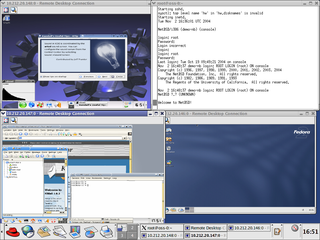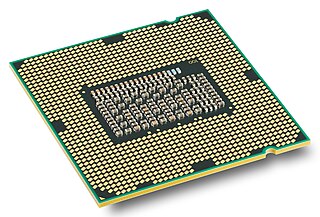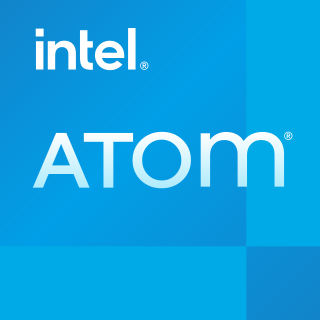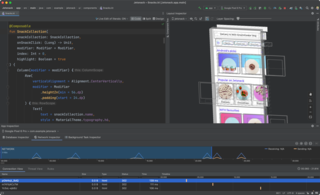Related Research Articles

Advanced Micro Devices, Inc., commonly abbreviated as AMD, is an American multinational semiconductor company based in Santa Clara, California, that develops computer processors and related technologies for business and consumer markets.


Itanium is a discontinued family of 64-bit Intel microprocessors that implement the Intel Itanium architecture. The Itanium architecture originated at Hewlett-Packard (HP), and was later jointly developed by HP and Intel. Launched in June 2001, Intel initially marketed the processors for enterprise servers and high-performance computing systems. In the concept phase, engineers said "we could run circles around PowerPC, that we could kill the x86." Early predictions were that IA-64 would expand to the lower-end servers, supplanting Xeon, and eventually penetrate into the personal computers, eventually to supplant RISC and complex instruction set computing (CISC) architectures for all general-purpose applications.

A microprocessor is a computer processor where the data processing logic and control is included on a single integrated circuit (IC), or a small number of ICs. The microprocessor contains the arithmetic, logic, and control circuitry required to perform the functions of a computer's central processing unit (CPU). The IC is capable of interpreting and executing program instructions and performing arithmetic operations. The microprocessor is a multipurpose, clock-driven, register-based, digital integrated circuit that accepts binary data as input, processes it according to instructions stored in its memory, and provides results as output. Microprocessors contain both combinational logic and sequential digital logic, and operate on numbers and symbols represented in the binary number system.

Microsoft Office, or simply Office, is a discontinued family of client software, server software, and services developed by Microsoft. It was first announced by Bill Gates on August 1, 1988, at COMDEX in Las Vegas. Initially a marketing term for an office suite, the first version of Office contained Microsoft Word, Microsoft Excel, and Microsoft PowerPoint. Over the years, Office applications have grown substantially closer with shared features such as a common spell checker, Object Linking and Embedding data integration and Visual Basic for Applications scripting language. Microsoft also positions Office as a development platform for line-of-business software under the Office Business Applications brand.
XScale is a microarchitecture for central processing units initially designed by Intel implementing the ARM architecture instruction set. XScale comprises several distinct families: IXP, IXC, IOP, PXA and CE, with some later models designed as system-on-a-chip (SoC). Intel sold the PXA family to Marvell Technology Group in June 2006. Marvell then extended the brand to include processors with other microarchitectures, like ARM's Cortex.

PCI Express, officially abbreviated as PCIe or PCI-e, is a high-speed serial computer expansion bus standard, designed to replace the older PCI, PCI-X and AGP bus standards. It is the common motherboard interface for personal computers' graphics cards, sound cards, hard disk drive host adapters, SSDs, Wi-Fi and Ethernet hardware connections. PCIe has numerous improvements over the older standards, including higher maximum system bus throughput, lower I/O pin count and smaller physical footprint, better performance scaling for bus devices, a more detailed error detection and reporting mechanism, and native hot-swap functionality. More recent revisions of the PCIe standard provide hardware support for I/O virtualization.

x86-64 is a 64-bit version of the x86 instruction set, first released in 1999. It introduced two new modes of operation, 64-bit mode and compatibility mode, along with a new 4-level paging mode.

Windows 7 is a major release of the Windows NT operating system developed by Microsoft. It was released to manufacturing on July 22, 2009, and became generally available on October 22, 2009. It is the successor to Windows Vista, released nearly three years earlier. Windows 7's server counterpart, Windows Server 2008 R2, was released at the same time. Windows 7 remained an operating system for use on personal computers, including home and business desktops, laptops, tablet PCs and media center PCs, and itself was replaced in November 2012 by Windows 8, the name spanning more than three years of the product.

Xen is a free and open-source type-1 hypervisor, providing services that allow multiple computer operating systems to execute on the same computer hardware concurrently. It was originally developed by the University of Cambridge Computer Laboratory and is now being developed by the Linux Foundation with support from Intel, Citrix, Arm Ltd, Huawei, AWS, Alibaba Cloud, AMD, Bitdefender and epam.

Unified Extensible Firmware Interface is a specification that defines the architecture of the platform firmware used for booting and its interface for interaction with the operating system. Examples of firmware that implement the specification are AMI Aptio, Phoenix SecureCore, TianoCore EDK II, InsydeH2O. UEFI replaces the BIOS which was present in the boot ROM of all personal computers that are IBM PC compatible, although it can provide backwards compatibility with the BIOS using CSM booting. Intel developed the original Extensible Firmware Interface (EFI) specification. Some of the EFI's practices and data formats mirror those of Microsoft Windows. In 2005, UEFI deprecated EFI 1.10.

A tablet computer, commonly shortened to tablet, is a mobile device, typically with a mobile operating system and touchscreen display processing circuitry, and a rechargeable battery in a single, thin and flat package. Tablets, being computers, have similar capabilities, but lack some input/output (I/O) abilities that others have. Modern tablets largely resemble modern smartphones, the only differences being that tablets are relatively larger than smartphones, with screens 7 inches (18 cm) or larger, measured diagonally, and may not support access to a cellular network. Unlike laptops, tablets usually run mobile operating systems, alongside smartphones.

Sandy Bridge is the codename for Intel's 32 nm microarchitecture used in the second generation of the Intel Core processors. The Sandy Bridge microarchitecture is the successor to Nehalem and Westmere microarchitecture. Intel demonstrated a Sandy Bridge processor in 2009, and released first products based on the architecture in January 2011 under the Core brand.

Intel Atom is a line of IA-32 and x86-64 instruction set ultra-low-voltage processors by Intel Corporation designed to reduce electric consumption and power dissipation in comparison with ordinary processors of the Intel Core series. Atom is mainly used in netbooks, nettops, embedded applications ranging from health care to advanced robotics, mobile Internet devices (MIDs) and phones. The line was originally designed in 45 nm complementary metal–oxide–semiconductor (CMOS) technology and subsequent models, codenamed Cedar, used a 32 nm process.
Google Chrome is a cross-platform web browser developed by Google. It was first released in 2008 for Microsoft Windows, built with free software components from Apple WebKit and Mozilla Firefox. Versions were later released for Linux, macOS, iOS, and also for Android, where it is the default browser. The browser is also the main component of ChromeOS, where it serves as the platform for web applications.

The Minnesota Supercomputing Institute (MSI) in Minneapolis, Minnesota is a core research facility of the University of Minnesota that provides hardware and software resources, as well as technical user support, to faculty and researchers at the university and at other institutions of higher education in Minnesota. MSI is located in Walter Library, on the university's Twin Cities campus.
The version history of the Android mobile operating system began with the public release of its first beta on November 5, 2007. The first commercial version, Android 1.0, was released on September 23, 2008. The operating system is developed by Google on a yearly cycle since at least 2011. New major releases are announced at Google I/O along with its first public beta to supported Google Pixel devices. The stable version is then released later in the year.

A Chromebook is a laptop or tablet running the Linux-based ChromeOS as its operating system. Initially designed to rely heavily on web applications for tasks using the Google Chrome browser, Chromebooks have since expanded to be able to run Android and full-fledged Linux apps since 2017 and 2018, respectively. All supported apps can be installed and launched alongside each other.

Android Studio is the official integrated development environment (IDE) for Google's Android operating system, built on JetBrains' IntelliJ IDEA software and designed specifically for Android development. It is available for download on Windows, macOS and Linux based operating systems. It is a replacement for the Eclipse Android Development Tools (E-ADT) as the primary IDE for native Android application development.

The Intel Management Engine (ME), also known as the Intel Manageability Engine, is an autonomous subsystem that has been incorporated in virtually all of Intel's processor chipsets since 2008. It is located in the Platform Controller Hub of modern Intel motherboards.
References
- ↑ Vance, Ashlee (10 November 2009). "Intel Sells Its Own Reader for the Health Care Market - Bits Blog - NYTimes.com". Bits.blogs.nytimes.com. Retrieved 25 June 2010.
- ↑ "An eReader With a Purpose". ABC News. 11 November 2009. Retrieved 25 June 2010.
- ↑ Mossberg, Walter S. (18 November 2009). "A Review of the Intel Reader - WSJ.com". Online.wsj.com. Retrieved 25 June 2010.
- ↑ Wildstrom, Stephen H. (3 December 2009). "The Intel Reader: As Big a Boon as Braille?". BusinessWeek. Archived from the original on 7 December 2009. Retrieved 25 June 2010.
- ↑ "World Service Programmes - Digital Planet, 24 November 2009". BBC. Retrieved 25 June 2010.
- ↑ "New Device Turns Text into Speech - Video". FoxBusiness.com. 28 December 2009. Retrieved 25 June 2010.